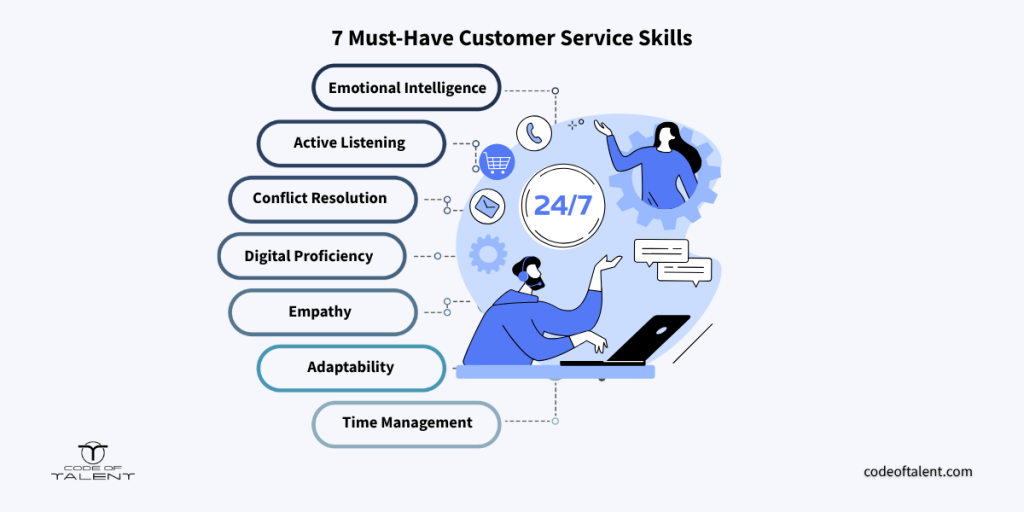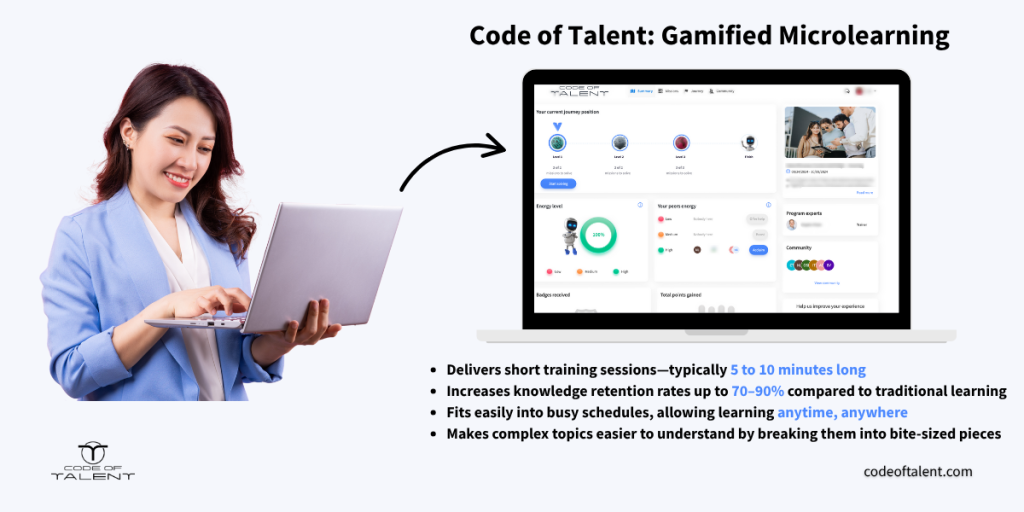The skills needed for customer service have evolved drastically, but training has not kept pace. Bad customer experiences cost organizations around the world a staggering $3.7 trillion in 2024, according to research from Qualtrics. That number reflects more than just a few mishandled calls or late responses, as the issue isn’t always rooted in broken systems. More often, it’s the people on the front lines who are not prepared for client-facing demands.
According to PwC, 32% of consumers say they would walk away from a brand they love after just one bad experience. That number climbs to 50% after multiple negative interactions. But what defines a “good experience” today? It’s not just efficiency or resolution. It’s speed, convenience, consistency, and most importantly, the human touch. This is why businesses must rethink how they train their people and what they’re training them for.

What are the Skills Needed for Customer Service Today?
Customer expectations are higher than ever. To meet and exceed them, these seven core skills are non-negotiable for any customer-facing employee.

1. Emotional Intelligence
Emotional intelligence (EQ) is the backbone of effective communication, the ability to understand, manage, and express emotions constructively. This soft skill is a must-have in customer service jobs that often involve high stress and emotional conversations. For instance, Harvard Business Review found that 90% of high-performing professionals score high in EQ.
In practice, this means recognizing when a customer is angry, frustrated, or anxious, even if they don’t say it directly. It also implies managing your own emotional response, staying calm, and choosing your words with care.
Key behaviors include:
- Staying calm and using validating language like “I understand why that’s frustrating.”
- Pausing and taking a breath before responding, avoiding immediate reactions.
- Speaking with empathy and maintaining calm under pressure.
- Focusing on lowering tension instead of matching the customer’s intensity.
2. Active Listening
According to Edgar Dale’s Cone of Experience, people remember only 20% of what they hear during a conversation. That means most of what’s said is forgotten. This is especially important in customer-facing roles, where missing details can lead to frustration, repeat interactions, and unresolved issues.
Active listening helps close that gap. A study published in the Journal of Applied Psychology showed that active listening significantly improves customer satisfaction, especially after service failures. When customers feel heard, their frustration often softens, even if the solution takes time.
This skill in real life:
- Giving full attention to the conversation, avoiding phones, multitasking, or side talks.
- Maintaining eye contact and using body language that shows engagement.
- Asking follow-up questions to clarify and deepen understanding.
- Avoiding interruptions and allowing the customer to finish their thoughts.
- Echoing key points to confirm accuracy, such as “So you received the wrong item, and it was two days late?”
- Using simple affirmations like “I hear you” or “Thanks for explaining” to show appreciation for the customer’s input.
3. Conflict Resolution
Dealing with angry customers is a regular occurrence in this industry. Customer service reps are often the first to face customer frustration, even when they are not directly responsible for the issue.
This is why conflict resolution is one of the most important skills needed for customer service: it helps repair what was damaged and strengthen the relationship between customer and brand. Clients are more likely to remain loyal when conflicts receive appropriate responses, rather than being ignored or dismissed.
Key behaviors include:
- Listening carefully without interrupting.
- Staying neutral: “Let’s figure this out together.”
- Offering clear, realistic solutions: “We can either issue a refund or send a replacement.”
- Knowing when to escalate to a supervisor if needed.
- Asking for feedback at the end of the interaction for improvements.
4. Proficiency with Digital Tools
According to McKinsey, digital skills are in the highest demand for the fastest-growing jobs. In customer service, teams work across email, chat, social media, and CRM platforms. Digital proficiency matters because these tools are part of daily work and technology changes quickly.
Furthermore, customers expect fast services, which means that customer service reps must be comfortable with multiple systems and able to switch contexts quickly.
Key behaviors include:
- Including targeted training for each platform during onboarding.
- Conducting weekly walkthroughs of key platforms.
- Using mock scenarios to practice switching between channels.
- Keeping step-by-step guides accessible for new tools.
- Use tools like microlearning to break down complex ideas into easy-to-understand concepts. Microlearning involves delivering short regular training sessions of around 10 minutes.
5. Empathy
According to the Global Empathy Index, companies leading with empathy outperform competitors by at least 50% over five years. In a world filled with AI-generated content, computer chatbots, and script-led performances, empathy separates standard customer service from excellent service.
Building empathy in a team means training members to recognize emotions, validate feelings, and respond sincerely, skills that set a brand apart in today’s market.
Key behaviors include:
- Saying, “I can imagine how that felt” or “That sounds really disappointing.”
- Using names. It personalizes the exchange.
- Avoiding robotic phrases. Scripts should serve as a guide, not a shield.
6. Adaptability
Customer service is one of the most unpredictable jobs. Every customer, situation, context, procedure, and product is different. That’s why reps must be adaptable and ready to handle any challenge. Trends shift, companies evolve, and client expectations change, but customer service should always be prepared to meet those changes.
Adaptability means adjusting tone, language, and approach based on the situation. It also involves learning from each interaction.
Key behaviors include:
- Reflecting on difficult situations: What could have gone better?
- Staying open to feedback, both from customers and peers.
- Keeping up with industry and business trends: understanding customer needs, what sets the brand apart, and areas for improvement.
- Attending regular product training to stay updated on the latest changes.
- Adapting procedures in real time.
7. Time Management
In any customer-facing role, managing time effectively is one of the most important skills needed for customer service. Successful employees prioritize tasks, handle urgent issues promptly, and know when to escalate complex problems. They also use tools and processes to stay organized and avoid distractions during interactions.
Encouraging strong time management helps teams maintain consistent service levels while meeting customer expectations for timely support.
Key behaviors include:
- Prioritizing tasks according to urgency and importance.
- Delegating when necessary.
- Categorizing and batching similar tickets.
- Attending training sessions on teamwork and communication for a better collaboration.
How to Train Employees in These Skills Needed for Customer Service
Knowledge alone isn’t enough. Skills must be practiced, coached, and reinforced over time.
According to the American Society for Training and Development (ASTD), companies that invest more in training outperform their peers:
- 24% higher profit margins
- 218% more income per employee
- 26% higher price-to-book ratios
Besides the business benefits, training also improves employee morale. A recent survey from Amazon shows 71% of employees feel more satisfied when learning new skills. Amazon also found that upskilling can increase wages by 8.6%, which can lead to an overall higher employee satisfaction and engagement.
Effective Training Types for Upskilling in Customer Service
To build the skills needed for customer service, companies should use a mix of training methods that engage learners and promote real-world application. Here are some of the most effective approaches:
Microlearning
Delivering short lessons in just a few minutes helps learners absorb information better. Studies show retention rates from microlearning can reach 70–90%, far higher than traditional, longer training sessions.
On-the-Job Training
Microlearning also makes it possible for employees to access training materials anywhere, anytime:
- During breaks
- Before an important call or interaction (also known as on-the-job learning)
- At home
- On desktop
- On mobile
This also promotes daily practice, which has been proven to increase information retention rates and absorption.
Role-Playing & Scenario-Based Learning
Simulating difficult conversations prepares teams emotionally and mentally. This hands-on approach improves confidence and speeds up decision-making when real challenges arise. Some scenario-based training includes:
- Simulating conversations on various topics,
- Analyzing past experiences,
- Role-playing customer and employee interactions with different degrees of complexity.
Peer Feedback & Coaching
Learning from colleagues creates a supportive environment where feedback is immediate and relevant. According to MIT Sloan, developing key human skills like empathy, communication, and collaboration requires hands-on, immersive experiences. Peer coaching offers this kind of environment, helping team members actively build and strengthen these essential skills.
Gamification
A little competition can go a long way when it comes to increasing training engagement. Adding game-like elements such as points, badges, or levels taps into people’s natural competitive spirit, motivating them to complete training sessions and stay atop the leaderboards.
Gamification transforms otherwise tedious material, like product or compliance training, into something entertaining and enjoyable.
Measuring the Impact of Customer Service Skills on Business Results
Investing in the skills needed for customer service should show measurable results across key metrics. Here are some examples:
- Customer Satisfaction Score (CSAT): This metric measures how satisfied customers are with a specific interaction or overall service. Effective training equips reps with communication and problem-solving skills, helping them meet or exceed customer expectations and improve satisfaction scores.
- Net Promoter Score (NPS): NPS shows how likely customers are to recommend a company to others. It’s closely tied to empathy and how well reps resolve issues. Training focused on active listening and conflict resolution helps create positive experiences that encourage customer loyalty and referrals.
- First Contact Resolution (FCR): FCR tracks the percentage of customer issues resolved during the first interaction. Training that emphasizes product knowledge and troubleshooting helps reps to solve problems efficiently, reducing repeat contacts and improving this metric.
- Agent Retention and Engagement: Well-trained agents feel more confident and less stressed in their roles, leading to higher job satisfaction and lower turnover. Continuous learning opportunities keep agents engaged and motivated, directly impacting retention rates.
- Revenue Growth: Customers who receive excellent service are more likely to return, spend more, and recommend the brand to others. Training that enhances customer interactions supports stronger relationships, ultimately driving increased revenue.
Wrapping Up: The Impact of Training on Customer Service Skills
Customer service means more than just answering questions and solving issues. It’s about connecting with customers and exceeding their expectations. Without the right skills, even the best tools and products can fall short.
Code of Talent offers a dynamic platform designed to support real-world learning and continuous development. Key features include:
- Microlearning modules for short, focused training that boosts retention.
- Gamified progression paths to keep learners motivated and engaged.
- Peer coaching circles that encourage collaborative learning and immediate feedback.
- Mobile-friendly content for just-in-time learning anytime, anywhere.
- Scenario-based exercises to practice real-life customer interactions.

Investing in the skills needed for customer service is an investment in the entire business. Code of Talent helps organizations build those skills with training programs tailored to real challenges, empowering teams to deliver exceptional experiences every time. Start today: Try our free trial and build your own training program from scratch!
Cover photo: Freepik





